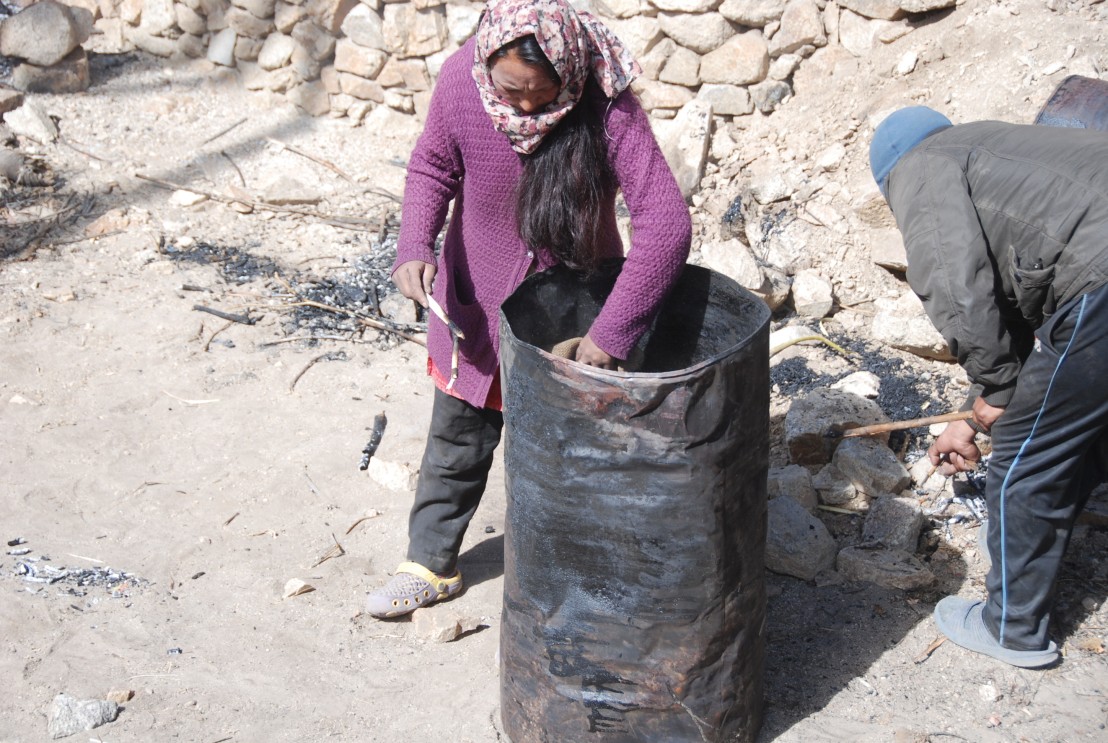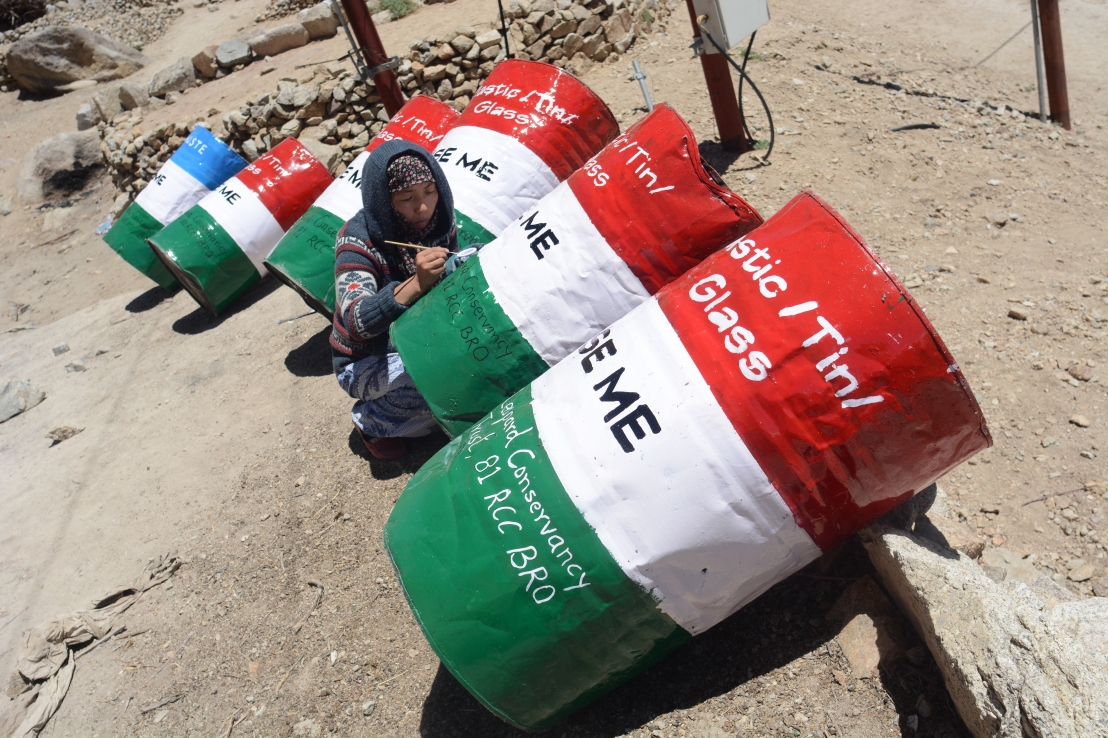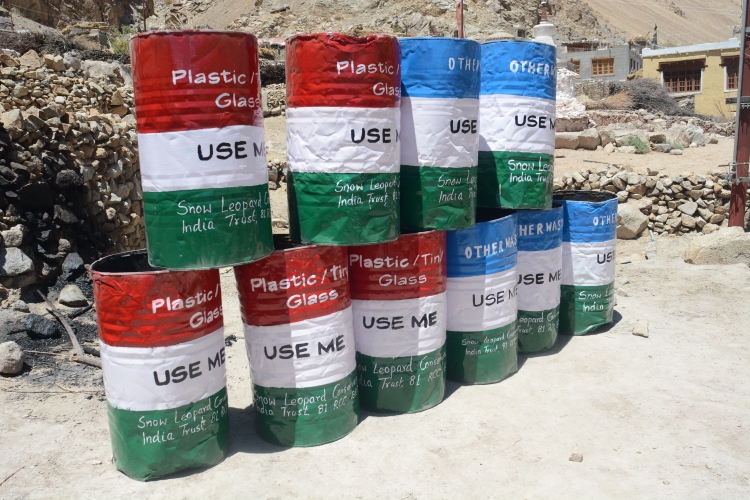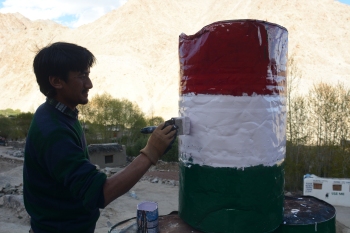Timothy Hefflinger is a William J. Clinton Fellow for Service with the American India Foundation (AIF). He has been working with the Snow Leopard Conservancy India Trust (SLC-IT) since September 2016. The following thoughts are his alone and do not necessarily represent the positions of SLC-IT or AIF.
Garbage is a problem here in Ladakh.
And SLC-IT has been working to solve the problem, from the Rong valley in the east to Zanskar in the West.
If you look at an issue as big as solid waste management, it’s clear that you can define the problem in a number of ways. This is important, because how you define the problem will determine what kinds of solutions you create.

For example, you can see the problem as a supply-side issue. (When dealing with wastes, the “product” is the wastes themselves – all those millions of biscuit wrappers and plastic water bottles that find their way to the region through both local and tourist consumption.) In the case of Ladakh, the problem, if seen from a supply perspective, is that there is far too much supply.
My analysis of the history of SLC-IT’s involvement in waste management over the years is that the initial perception (which may have been true a few years ago) was that it was mostly tourists causing waste problems. Early waste projects were centered around “garbage clean-up” days in rural villages, particularly those along trekking routes. It is important to understand that the problem was being defined by the influence of outsiders – tourists littering their plastic water bottles was a clear and obvious problem. Wastes collected in streams and meadows, and organizing their clean-up was not a terribly difficult way to remedy the problem of litter. These projects will likely continue to be needed for a long time, though hopefully as the cultural acceptability of litter decreases in Ladakh (and in India generally), their need will decrease.

Confronting this problem from the supply-side perspective, SLC-IT and some partners realized that if tourists could be encouraged to use re-usable water bottles and eat food that did not come wrapped in plastics, the problem of “too much supply” would be lessened. SLC-IT and its partners instituted the Himalayan Eco-Café program in 2002. The idea behind this program was that tourists would produce less wastes on an average trekking trip.
There has since been a reckoning in Ladakh that tourists were no longer the only ones producing (and polluting) solid wastes. As more and more goods and foods that enter Ladakh are wrapped in disposable packaging, locals themselves are generating a lot of solid wastes, many of which are not recyclable at all. This points to the greater problem of over-supply, from both tourists and locals. It’s not a problem unique to Ladakh, but the geographical scope of waste production is staggering in an area as huge and rugged as Ladakh.

The other way to think of the problem, however, is that of demand. It’s often convenient to think of solid wastes as just that – waste. But if you are forced to confront the problem on a large enough scale, it enters the realm of governance, public health, and economics. In order to effectively deal with solid wastes, society must place some “value” on their disposal. We must come together and realize that individuals cannot solve the problem of solid wastes, but that it’s a project for a collective. We must therefore create “demand” for wastes, in order for them to be valued, in order for them to be appropriately dealt with.
Now, it’s far beyond the capacity of SLC-IT to begin municipal waste collection in a place like Leh, for example. At least in some places like Leh city, the municipality is gathering wastes in an organized fashion. Once a week, a dump truck rumbles through the streets, its loud-speaker on top announcing its presence. People deliver their wastes to the workers on the truck, who usually return the waste bins and bags on-the-spot. It’s not a glamorous system, but it works.
It’s trickier in the rural villages, but SLC-IT has been working on waste collection there too. For now, SLC-IT has decided to keep its involvement to those areas most likely to be frequented by tourists, not all of whom are yet keen on minimizing their waste outputs. SLC-IT has built masonry waste-collection areas in four villages and locations throughout the region, with plans for more in the future.
Each waste collection area (whether or not a masonry shed has yet been built) features two or three heavy steel drums in which wastes can be deposited. The drums themselves were re-purposed from work sites along new roadways in Ladakh. As the Border Roads Organization makes new roads, they use thousands of these drums filled with tar, and after the tar is melted out of them and mixed into new asphalt road surfaces, most of the drums are purposeless. Through a partnership with the Border Roads Organization, SLC-IT takes as many barrels as they can, cleans them up with the help of villagers, and paints them. This gives them a “second life.”
The barrels themselves are divided into two categories. The first is labeled “Plastics, Tin, Glass” and can be thought of broadly as recyclable materials. The second is labeled “Other Wastes” and usually end up filled with organic wastes or those wastes that are not recyclable. The masonry sheds separate wastes by “Paper,” “Plastic,” and “Metal.”
This puts us face-to-face with the issue of demand. First, I’d like to point out that there was once very high demand for compostable materials in Ladakh, but this demand is waning. The first reason for this is that people are raising less livestock than they used to. Goats, sheep, and cows were once prime disposers of compostable wastes – people would feed all their kitchen scraps to their livestock. You can still see this today, even in Leh city, but in general, as people care for less livestock, organic wastes are being treated more and more like “a problem” instead of “something to feed to the cow.” The second reason is that artificial fertilizers have supplanted a lot of compost use in the region. There isn’t as much composting going on as there used to be, so organic wastes are problematic.
The other lack of “demand” is for recyclable materials, but this problem is not unique to Ladakh or India. Market demand for recycled materials almost everywhere in the world is usually lower than is optimal because recycled materials are usually lower quality (and sometimes more expensive) than virgin materials. Recycling is also energy, labor, and carbon intensive, so it’s not always easy to justify recycling something if it’s dirtier for the environment than producing something anew. These conversations are beginning to become more common here in Ladakh, but for the time being, I do not know of any recycling capacity here whatsoever. As I understand it, those bins for “recyclable” materials don’t yet connect to recycling factories on the far end. Not yet, anyway.

For now, wastes are deposited where most other collected wastes in Ladakh are destined: landfills. This is far from an “ideal” solution, as it does nothing to confront the fundamental problem of over-supply. It also does not create “demand” for recyclable materials. But in the absence of municipal capacity to deal with recyclable wastes, it’s the best that can be done. And it’s certainly better than incinerating wastes, which is the only option left for villagers when wastes mount up. The landfills (near the village of Sabu to the east of Leh) themselves need to be regulated and held to higher environmental standards than they currently are. For example, I have been told that they are not “sanitary” landfills (with thick clay bottom layers to prevent leakage, etc.), but are open-air waste pits. This is problematic, so I suspect that will be the next barrier to cross.
For SLC-IT, the plans are to link these “Plastic, Tin, Glass” rubbish bins with real recyclers in the future. SLC-IT is looking into the possibility of collecting these materials and trucking them to Jammu (the nearest recycling facilities) aboard trucks that would otherwise be making that drive empty. (I have been told that many trucks delivering goods and supplies to Leh from Jammu return empty after dropping their cargoes.) SLC-IT will need to fully develop those partnerships to make that a reality. I also hope there is more research done to understand the life-cycle of recyclable materials in Ladakh, and what can be done to not only make them less carbon intensive, but to create real markets for them.
So, in conclusion, SLC-IT is attempting to tackle the problem of solid wastes from multiple angles. I should also mention that the group works to educate Ladakhis (and foreigners, when possible) about sustainable waste solutions. Most education programs sponsored or hosted by SLC-IT include a component on managing wastes, especially those for school children. For now, SLC-IT is attempting to solve these problems while advocating for bigger changes – changes at the local, state, and national levels. I applaud SLC-IT in their efforts, and hope to see their vision of a clean, safe Ladakh fully realized.

–By Timothy Hefflinger








